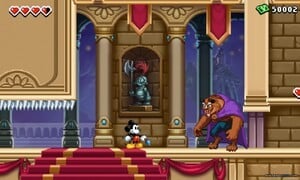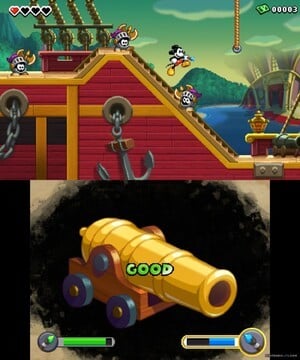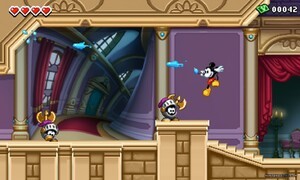
We're suckers for retro here at Nintendo Life, and we certainly found our interest piqued when Disney Interactive revealed that it's upcoming portable title Disney Epic Mickey: Power of Illusion was to be a 16-bit-style sequel to the Mega Drive's Castle of Illusion Starring Mickey Mouse. We tracked down Peter Ong, co-founder and creative director of DreamRift and game director on the Mouse's upcoming outing, to get the lowdown.
Nintendo Life: How did you find yourselves working with Disney?
Peter Ong: DreamRift had just finished our Nintendo DS game, Monster Tale, and I began to brainstorm with our co-founder/technical director, Ryan Pijai, to discuss what we’d like to make next. One of the ideas that we were excited about was a Nintendo 3DS concept where the player could paint or draw objects on the bottom screen, which would then change into beautiful images that become an interactive part of a game-play environment. With that concept in mind, we began to talk to different publishers including Disney Interactive…whom we had a great relationship with. We were always very interested in collaborating in the future.
Subscribe to Nintendo Life on YouTube841k
Miraculously, everything aligned more perfectly than we could have imagined.
By coincidence, Disney was also interested in bringing the Disney Epic Mickey experience to the 3DS, which greatly excited us, being huge Disney fans, and having much respect for industry legend Warren Spector and his team’s very passionate approach to the first Disney Epic Mickey game. To our delight, they expressed that their top priorities in bringing Disney Epic Mickey to the 3DS were to make the highest quality game possible, and also for it to be a unique experience rather than a port of the console version. Miraculously, everything aligned more perfectly than we could have imagined. It just so happened that the central mechanic that we had been prototyping was a great fit already for the idea of bringing Disney Epic Mickey to the 3DS, since in the console version, the core mechanic involves empowering the audience to control Mickey and paint objects into reality within your interactive environment. It was immediately apparent to us that our fledgling game concept was a fantastic fit for bringing Disney Epic Mickey to the 3DS.

NL: The Disney Epic Mickey titles on Wii are 3D platformer affairs, whereas Disney Epic Mickey: Power of Illusion has a retro pixel look. What led you down this path?
PO: Our approach with this game was to use traditional hand-drawn 2D visuals in order to closely capture the essence of Disney’s amazing historic imagery, which was also traditionally created and animated in 2D. One thing that pleasantly surprised us while working on a 3DS game with traditional 2D art, is that we found that the stereoscopic 3D effect to be most striking when paradoxically it’s combined with 2D visuals. I think that players are quite used to polygon-based 3D games on the 3DS. It’s just taken for granted and expected that those games be portrayed in stereoscopic 3D since they are meant to convey a pseudo-3D experience in the first place. However, when our 2D visuals are combined with stereoscopic 3D, the effect is something that people may not expect on the 3DS. You never really see that kind of thing in the real world, and therefore it really stands on when it’s in front of you on the 3DS.
NL: How does the portable game fit with the console entries?
PO: This game takes place within the Castle of Illusion, and it also takes place within the universe of Disney Epic Mickey. Power of Illusion’s story begins with the Castle of Illusion from the classic Sega Genesis/Mega Drive game having appeared in Wasteland, which players of Disney Epic Mickey will be familiar with.

NL: How are you dabbling with touch or motion controls?
PO: We’re utilising the bottom screen in a unique matter. The game empowers the audience to create and define their interactive platforming environment on the top screen by using the stylus and touch screen to paint objects that upon completion, cross from the bottom screen into the top screen and become an interactive part of in-level gameplay. Furthermore, based on how well a player performs in using the painting mechanics on the bottom screen, the objects created by the player will have different properties and effects within the action-platforming gameplay on the top screen.
NL: Dubbing it an "Illusion" title tickles our 16-bit nostalgia, and going in has certain expectations on it. Name aside, what makes Power of Illusion a Castle of Illusion game? Is there anything from the 16-bit games that you're hoping to preserve?
PO: We’re huge fans of Castle of Illusion Starring Mickey Mouse, so we also put big expectations upon ourselves as we work on this game. It’s a mind-blowing opportunity to be able to share our appreciation for how incredible Castle of Illusion was. With the way that Power of Illusion looks, sounds and plays, we’re looking to do honour to the spirit of the classic game. For example, in terms of gameplay, the audience may notice moves that are familiar to Castle of Illusion such as Mickey’s ability to jump into the air and bounce off enemies. DreamRift’s art director, Michael Veroni, also grew up with a deep appreciation for Castle of Illusion, and it’s evident throughout this game’s environments.
One of the amazing things in the original game was that each level was a surreal illusion featuring different imagery and settings from Disney masterpieces. In our game, we’re also drawing inspiration from famous Disney works in celebration of Disney’s universally cherished history.
NL: How big an influence have previous Mickey games been on the development of this title?
PO: This is a Disney Epic Mickey game that draws inspiration from many places. While Castle of Illusion remains the primary classic influence for this game, we are also fans of other Mickey games.

NL: Many at DreamRift worked on Henry Hatsworth in The Puzzling Adventure for EA and your first release as a studio was Monster Tale, both rather lovely 2D platformers, and now you've got Mickey Mouse in the house. How are you finding working on a well-established license compared to your own original creation?
PO: Thank you for the kind compliment regarding both Hatsworth and Monster Tale. I guess you could say the protagonists from those previous titles, Henry and Ellie, are in good company with Mickey! Historically, DreamRift’s core members have thrived on creating original properties, so we always knew it would take something really special in order for us to tackle our first game within an existing universe. We often pinch ourselves to remind us that it’s not a just a dream that we are actually working with not only Mickey Mouse, but the Castle of Illusion, and a ton of other amazing Disney classics such as Beauty and the Beast, Peter Pan and Alice in Wonderland — all at the same time!
So far, the biggest differences we have encountered between working on an original property and an existing universe are the audience’s prior awareness of the property, and the absolute need to maintain the integrity of a pre-existing universe.
Thanks to Peter for his time.





Comments 24
Excited for this.
This interview has me even more stoked for this. I can't wait to see what these guys can do, what with there previous accomplishments.
My body is so ready for this game.
I loved the Mickey's Magical Quest games on the SNES so there is no reason I shouldn't enjoy this one.
16-bit you say? Nice! If only they would release SNES games on 3ds vc.....
I want this game so bad. Can't wait for October. My birthday is that month. I will definitely be pre-ordering this game.
I think i remember playing castle of illusion before actually. I remember a black and white dockyard area where you can bounce on pete's belly. I also remember walking up a giant spiral staircase which looked kinda 3d.
Looking more forward to this than the Wii game.
There isn't really a sequel to Epic Mickey, you are just being tricked by Peter Ong's power of illusion.
I'm excited for this, and I wish World of Illusion was a download for Virual Console
Really looking forward to this! Let's hope for tonnes of retro love and references. Day one purchase this! Oh and hi everyone! I'm new
Another horrible game...
Says someone who has never played said game.
@MrArcade Sounds like you're thinking of Mickey Mania, which wasn't really connected to the Illusion games, but was an awesome game as well.
I can't wait for the game to be released
I am very, very excited about this game!!
A nice interview, sounds like they are really committed to this one.
My favourite version so far.
Probably get this.
@Zenarium, wow, you must have great perception skills. I did not know it was possible to completely assess a game's worth based on a few screenshots. How do you do it? (sarcasm)
This looks fun, and it doesn't hurt that the director is attractive either. haha
I agree with him that 2D layers look incredible on the 3DS with depth added. I loved that papercraft look in the 3D Classics remake of Kirby's Adventure. For some reason, however, it seems that a certain portion of players just can't see that form of depth and shrug as if there's no 3D at all. Well, screw them, I'm with this guy.
; )
@Seven_Force oh yes, thats the one!
I'm also excited for this game. A sure purchase for me. Castle of Illusion and World of Illusion were 2 of the games that made me want to track down another Sega Genesis.
I can't wait for this game to come out!
Show Comments
Leave A Comment
Hold on there, you need to login to post a comment...